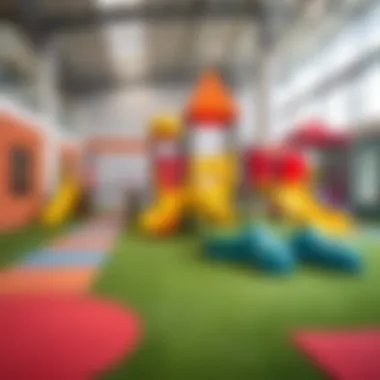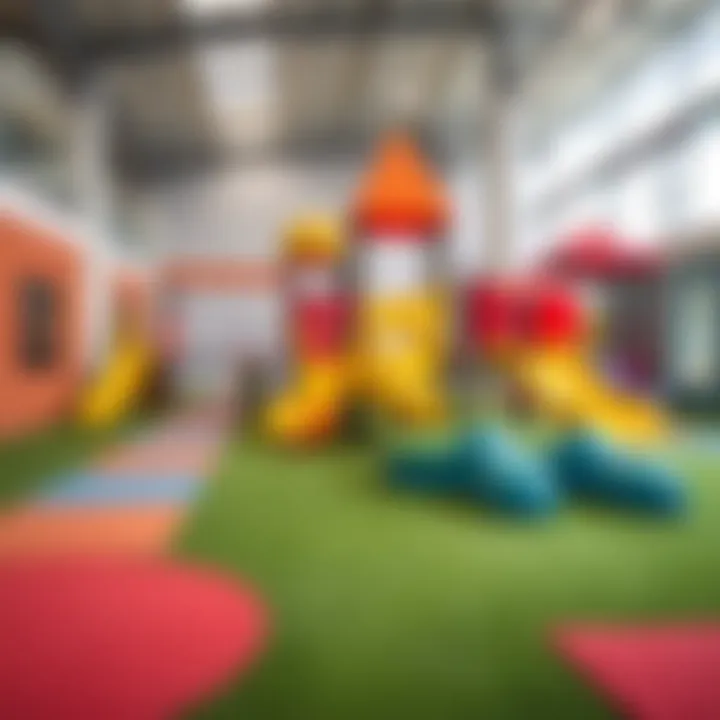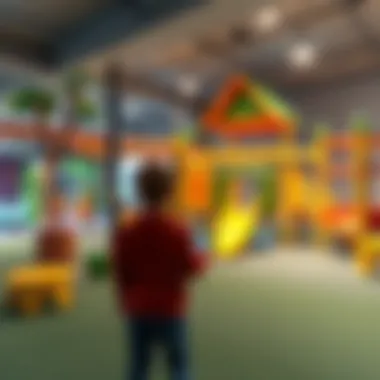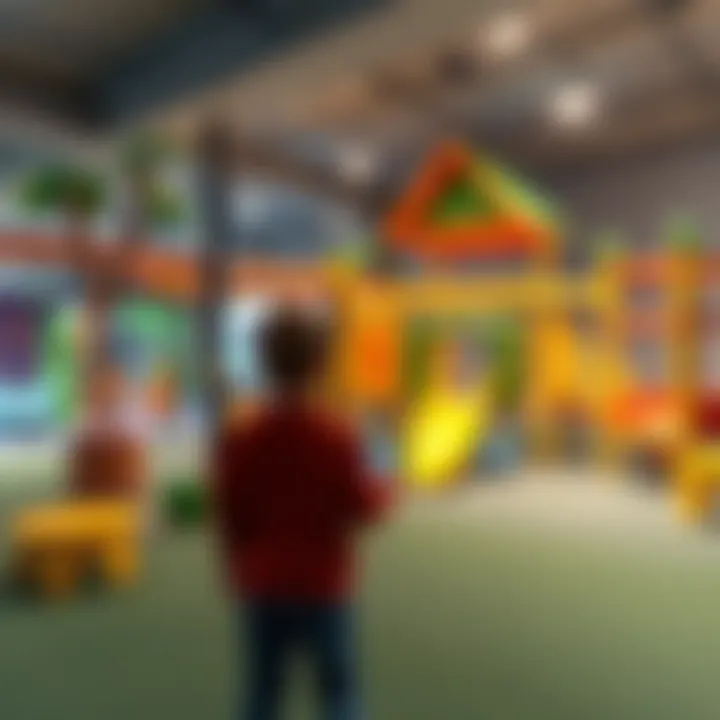Exploring Play Areas for Kids: A Comprehensive Guide


Intro
In today's fast-paced, tech-driven world, the significance of play areas for children can't be overstated. These spaces do much more than merely provide a place for kids to burn off energy. Well-designed play areas foster creativity, promote social skills, and support physical development. This comprehensive guide explores the multifaceted aspects of children's play areas, providing insights valuable to investors, real estate agents, homebuyers, and community managers alike.
The focus will be on understanding the critical role these spaces play in children's growth, addressing essential safety considerations, and examining the innovative design elements emerging in urban settings. Special mention will be made of the trends observed in prominent cities, particularly Dubai, where luxury and functionality coalesce to create exceptional environments for child play.
"A strategic play area in your community not only serves children but also enhances property values and attracts families, making it a smart investment for neighborhoods" - Willemarie, Urban Development Analyst.
As we delve deeper, we'll present current market trends, investment opportunities, and what stakeholders need to consider when embarking on such projects.
Prolusion to Play Areas for Kids
Play areas for kids are often seen as simple spaces filled with swings, slides, and climbing structures. However, this initial perception barely scratches the surface. These areas are crucial not just for amusement but also for laying the groundwork for various essential skills in children. Understanding the dynamics and advantages of play areas is essential for stakeholders—from urban planners to parents, and investors alike.
Play areas serve multiple purposes: they are venues for physical exertion, platforms for social interactions, and environments that stimulate cognitive development. When children engage in play, they are not just passing time; they are learning to navigate their world, build relationships, and solve problems. Each swing taken or slide soared down is a step towards mastering their own bodies and understanding their environment.
In an age where digital distractions are omnipresent, the role of physical play areas has become even more vital. Outdoor spaces encourage children to step away from screens and engage in activities that bolster their physical health and emotional well-being. Besides, these areas facilitate social skills by allowing kids to interact with each other in collaborative games or friendly competitions.
Considerations about play areas should include safety features, community access, and environmental impact. As cities expand, the need for thoughtfully designed play spaces intensifies, ensuring that every child—regardless of background—has the opportunity to engage in meaningful playtime experiences. This article aims to cover the significance of these play areas surrounding child development, design essentials, safety considerations, and innovative trends.
"Play is the highest form of research." - Albert Einstein
By examining these aspects in detail, we will unveil how well-planned play areas can serve not just as recreational spots but as integral components of community infrastructure that foster growth, inclusion, and sustainability. As we delve into each segment, the intricate role of these environments in shaping well-rounded individuals will come to light, revealing their importance in the larger discussion of urban development and community health.
Importance of Play Areas in Child Development
Understanding the significance of play areas in child development is fundamental for stakeholders involved in urban planning, real estate, and childhood education. These spaces serve as critical environments where children's diverse growth needs are addressed. Investing in play areas is investing in the future of children; their positive impact ripples not just through the childhood years but extends into adulthood.
Physical Development
Play areas contribute significantly to physical development. When children engage in activities like climbing, running, jumping, and swinging, they're not just frolicking around. They're building vital motor skills needed for everyday life. For instance, climbing structures help enhance coordination and strength, while open spaces promote running and agility.
Moreover, such physical activities contribute to healthier lives. They combat sedentary lifestyles, teaching kids early on the importance of being active. In communities where access to spacious parks and play areas is limited, children might miss out on these essential physical health benefits. Parents and urban planners alike should prioritize creating easily accessible play areas that promote overall well-being.
Social Skills
In the realm of social development, play areas act as vibrant arenas for interactivity. Children learn how to collaborate and communicate with various peers in these settings. Engaging in shared activities, whether it's a game of tag or building a sandcastle, helps them develop teamwork and conflict resolution skills.
For example, when two children want the same swing, they must navigate their desires and negotiate who goes first. Such interactions not only foster friendships but also teach important social nuances that are crucial as kids grow older. Consequently, well-structured play areas with diverse activities can serve as catalysts for nurturing social competencies among children, equipping them for more complex relationships in the future.
Cognitive Growth
Play areas are not just about physical exertion; they significantly contribute to cognitive development too. When children engage in imaginative play, such as pretending to be explorers or astronauts, they exercise their creativity and critical thinking. These activities stimulate brain development and enhance cognitive abilities, making children more adept learners.
Structured play, like puzzle-solving on playground equipment, encourages problem-solving skills. Often, children encounter challenges that demand they think on their feet, thus enhancing their decision-making abilities. The combination of physical and mental engagement in play environments fosters an overall enriched learning experience.
"Play is the highest form of research." - Albert Einstein
This quote speaks to the essence of play areas in a child's life, positioning them as vital components in developing well-rounded individuals. To further support cognitive growth, play areas must integrate varied experiences, allowing for diverse learning opportunities.
As we delve deeper into the various elements influencing play areas, it's essential to recognize that investing in these spaces is investing in a child's future. A well-designed play area acts as a microcosm of learning and development, benefiting society as a whole.
Types of Play Areas
Understanding the different types of play areas that are available for children is crucial for both parents and stakeholders in child development. These spaces provide opportunities for kids to explore, learn, and engage in physical activity, which are all critical for their growth. The design and structure of these play spaces can greatly influence a child's experience and development.
Indoor Play Areas
Indoor play areas offer a controlled environment where children can play regardless of the weather outside. These spaces are often equipped with various structures and equipment designed to enhance physical and social skills. One distinct advantage of indoor play areas is their ability to incorporate features that stimulate children's imaginations. For example, some facilities have themed rooms that resemble jungles or castles, encouraging kids to immerse themselves in imaginative play.
- Benefits:
- Shielded from harsh weather conditions, making playtime possible year-round.
- Often features safety padding and structures that minimize injuries.
- Usually maintained to high hygiene standards.
However, a few considerations must be kept in mind. Typically, the available space can be limited, affecting the types and numbers of children who can play simultaneously. Moreover, the costs of admittance can be quite steep, which may limit access for some families.
Outdoor Play Areas
Outdoor play areas are perhaps the quintessential playground experience. These spaces often consist of natural elements, equipment like swings, slides, and climbing frames, and wide open areas for running and playing games. They not only provide a physical space for play but also encourage children to connect with nature.
- Benefits:
- Promote physical health through active play in an open environment.
- Exposure to natural elements aids in sensory development.
- Social interactions occur more naturally in larger, open spaces.
The open nature of outdoor play areas facilitates a form of exploration that is often absent in indoor settings. However, weather conditions, like rain or extreme heat, can limit usage, making it essential for these areas to have shaded zones or alternative indoor structures for inclement weather.
Water Play Areas
Water play areas engage children’s senses and often offer a different experience compared to traditional play. These spaces use water-themed equipment like sprinklers, fountains, and shallow pools that not only provide enjoyment but also valuable lessons in motor coordination and social interaction. For instance, water play can teach children about the principles of buoyancy as they play with floating objects.


- Benefits:
- Encourages sensory exploration and creativity through water.
- Provides relief in hot weather, making play refreshing.
- Facilitates cooperative play as children typically gather around water features.
Nonetheless, safety is paramount, and these areas require stringent supervision and maintenance to ensure that children are safe from drowning hazards and that the water quality remains high.
Adventure Playgrounds
Adventure playgrounds represent a dynamic take on traditional play areas by focusing on risk-taking in a controlled environment. These spaces often include unique structures like climbing walls, zip lines, and rope bridges that challenge children physically and mentally. Children engage in supervised risk while exploring their limits and developing confidence in their ability to navigate obstacles.
- Benefits:
- Cultivate a sense of adventure and independence in children.
- Foster problem-solving skills through challenge-based play.
- Create opportunities for social interaction and teamwork.
While adventure playgrounds cater to older children looking for thrills, safety remains a critical consideration. Proper design, supervision, and equipment maintenance are essential to ensure that these spaces provide excitement without compromising child safety.
Safety Considerations
Safety is the cornerstone of any play area for children. When designing or evaluating play spaces, we must prioritize safety since it's integral to ensuring a positive and enjoyable environment for kids. Attention to safety considerations can make a significant difference in reducing accidents and promoting carefree play. Parents and guardians often look for safe playgrounds, but safety shouldn't be an afterthought; it should be embedded in the very fabric of design and operation. Here are several crucial aspects we need to explore.
Design Standards
Design standards define the framework that specifies how play areas should be created and maintained. These regulations ensure the equipment and play spaces meet certain safety benchmarks. For instance, in the United States, the Consumer Product Safety Commission provides guidelines that address various facets of play area safety. Some of these design standards include:
- Height of Equipment: Limitations are set on how high climbing structures can be to prevent falls that could result in serious injuries.
- Space Between Equipment: A minimum distance between equipment allows for sufficient room and reduces the chance of accidents when multiple children are playing.
- Surface Material: Recommendations for safe surface materials such as rubber mulch or sand, which provide cushioning that absorbs impact during falls.
When these standards are adhered to, they not only protect children but also instill confidence in parents and guardians about their children’s safety.
Material Safety
When constructing play areas, the choice of materials plays a crucial role in ensuring safety. The materials should be non-toxic and free of harmful chemicals. For example:
- Wood: When selecting wooden structures, it’s essential to ensure that the wood is treated properly to prevent splinters and decay, opting for those verified as safe.
- Metal and Plastic: Equipment made from metal should be galvanized to prevent rust, while plastics must be UV-stabilized to withstand sun exposure without degrading or becoming hazardous.
- Surface Materials: As mentioned previously, soft surfacing like rubber mats or synthetic turf can reduce the risk of injuries. Children will fall, but having these materials can minimize the potential for harm.
By focusing on safe materials from the start, we help create an environment where children can enjoy playtime without added risk.
Maintenance of Play Areas
Even well-designed play areas need regular maintenance to remain safe. Regular checks can identify wear and tear or potential hazards. Vital maintenance steps include:
- Routine Inspections: Establishing a schedule for inspections can help catch issues like loose screws, damaged equipment, or surface degradation before they become serious problems.
- Cleaning: Keeping play areas clean can prevent accidents resulting from debris or broken toys.
- Repairs: Timely repairs are crucial. If something is broken or damaged, it should be fixed before being used again.
Consistent maintenance is not just a safety measure; it reflects a community’s commitment to providing children with a safe environment to learn and grow.
Neglecting maintenance can lead to tragic accidents, which can tarnish the reputation of a play area and deter families from returning. Investing in maintenance is essential for long-term safety and enjoyment.
Overall, prioritizing safety within play areas is about creating joyful experiences while minimizing risk. By adhering to design standards, using safe materials, and maintaining play areas correctly, stakeholders can ensure that children have access to safe, fun environments that contribute positively to their development.
Design Elements of Effective Play Areas
When it comes to play areas for kids, design elements are not just an afterthought; they form the backbone of a successful play space. These elements can make or break a child’s experience, influencing their play patterns and ensuring that the space is not only entertaining but also beneficial for their development. Well-designed play areas cater to a variety of needs, including safety, creativity, and social interaction, and they can significantly impact a child's willingness to engage in active play.
Incorporating Nature
One prominent aspect of effective play area design is the integration of natural elements. Many experts suggest that children benefit from experiences in nature, and incorporating green spaces can profoundly influence their play. This could mean including trees, gardens, or natural materials like wood and stone.
Natural play areas encourage kids to explore their surroundings, ignite their imagination, and promote hands-on interactions. Research shows that kids who play among natural features exhibit enhanced cognitive growth and develop a better understanding of ecological systems. For instance, a playground with logs for climbing or sand for building can serve as a mini ecosystem where children learn about nature while having fun. By blending elements of the outdoors with structured play, designers can cultivate a richer, more immersive experience.
Inclusion of Technology
In our ever-evolving world, the inclusion of technology in play areas is becoming increasingly popular. Interactive displays or sensor-based play equipment can engage kids in new ways that traditional playground equipment cannot. For example, a play area might feature augmented reality games that can be accessed through mobile devices or smart play integrated equipment that responds to children’s movements.
These technology-driven experiences can provide educational elements, teaching children about science, math, or even history in a dynamic environment. However, there exists a balance to be struck. While technology adds value, it's crucial that play areas don't become solely reliant on it. The aim should be to create spaces where tech and traditional play coexist cohesively, ensuring children receive a holistic experience.
Flexible Usage Spaces
Another pivotal design element is flexible usage spaces. These areas are versatile and can be adapted to serve various activities, from solitary play to group interactions, offering dynamic spaces for all types of play. Designing multipurpose zones that accommodate different age groups and interests enhances the play area’s accessibility and appeal.
For instance, think about spaces that can transform from a quiet reading nook to an interactive art section or a space for organized games. This adaptability invites children to engage in various forms of play, catering to their mood and interests at any given time.
Offering varied terrains, such as flat areas for games like soccer and hilly sections for adventurous climbing, can create exciting explorative opportunities, sparking creativity and encouraging cooperation among kids.
A thoughtful design isn't just about visual appeal; it's about creating a tapestry of experiences. Each element plays a role in helping children develop various skills as they navigate their world.
In summary, effective play areas should seamlessly incorporate nature, technology, and flexibility in their design. When designed thoughtfully, play spaces offer a nurturing environment that fosters development, encourages exploration, and builds community among children.
Trends in Play Area Design
Understanding modern trends in play area design is crucial for those involved in creating or investing in spaces that cater to children. As society evolves, so too does the understanding of how these areas can support not just play but also holistic development. The design trends reflect a shift toward environments that prioritize not only fun but also educational and growth opportunities for children.
Sustainable Play Areas


Sustainability in play areas is gaining ground fast. It encompasses using eco-friendly materials, minimizing environmental impact, and promoting outdoor play as a way to reconnect children with nature. Sustainable play areas materialize when local resources are utilized effectively, often transforming available land into vibrant spaces. For instance, using reclaimed wood and natural fibers reinforces the connection to nature while teaching children about conservation.
- Key Benefits of Sustainable Play Areas:
- Promotes environmental awareness among children, fostering stewardship from a young age.
- Reduces operational costs through energy-efficient designs and materials.
- Provides local communities a sense of pride and ownership in their play spaces.
Technology-Driven Play Experiences
With the rise of technology, play areas are becoming increasingly interactive. Technology-driven play experiences focus on integrating digital tools in a way that enhances outdoor activities. For example, interactive installations that react to children’s movements can bring traditional play structures to life. This encourages exploration and creativity, making playtime not just a physical activity, but an engaging learning experience.
- Considerations when implementing tech:
- Balance is key; too much reliance on screens can detract from physical activity.
- Ensure that technology is user-friendly, keeping children engaged without frustration.
- Safety protocols should always be in place to protect children from both physical and digital threats.
Collaborative Play Spaces
The concept of collaborative play spaces promotes social interaction and teamwork among children. These areas are designed with multiple users in mind, encouraging group activities that can enhance cooperative skills. For example, large climbing structures or team obstacle courses not only offer physical challenges but also foster community. When children play together, they learn to communicate and resolve conflicts, skills crucial to their development.
- Benefits of Collaborative Play:
- Encourages the development of social skills, including communication and cooperation.
- Reduces feelings of isolation and fosters a sense of belonging within the community.
As urban planners incorporate these trends into play area designs, they craft spaces that are not only safe and engaging but also instrumental in the development of essential life skills and environmental awareness among kids.
In summary, trends in play area design are steering toward sustainable practices, technology integration, and collaborative environments. Such aspects not only enhance the play experience but also offer meaningful impacts on children's development.
Examples of Notable Play Areas
Understanding and examining notable play areas is crucial for various stakeholders, including urban planners, parents, and developers. These examples showcase how innovative designs can enhance the play experience, while also demonstrating the significant benefits such areas offer to children's developmental needs. Drawing from diverse geographical and cultural contexts helps illustrate how play spaces can be tailored to meet local communities' unique requirements.
Local Playground Initiatives in Dubai
Dubai has taken significant strides in promoting children's welfare through its playground initiatives. Parks and play areas have rapidly evolved, reflecting the city's growth and its multicultural population. One standout example is the Al Barsha Park, which integrates vibrant playground structures with nature trails, allowing children to experience both active and exploratory play. The emphasis on greenery and shade in this area enhances outdoor play and fosters a stronger connection with nature.
These playgrounds often feature unique elements tailored to children from various backgrounds. For instance, the Umm Suqeim Park includes adaptive play equipment that enables children with disabilities to engage in activities alongside their peers, promoting inclusivity. Moreover, Dubai's commitment to safety is evident, as these areas comply with strict design standards ensuring materials used are safe, and the layout minimizes risks during play.
The community response has been overwhelmingly positive, with parents expressing appreciation for well-maintained, accessible spaces that prioritize their children's development and safety. Furthermore, these local initiatives have proven vital in creating social bonds among families, as parents often meet and interact while supervising their children.
International Best Practices
Globally, certain play areas set the gold standard in promoting innovative designs and inclusivity. One prime example is The High Line in New York City, which transformed an abandoned railway into a thriving public space featuring green parks and play areas. The High Line not only integrates art and nature but also prioritizes community involvement in its design, inviting locals to contribute ideas and feedback.
“A play area can change how a community interacts and grows, providing spaces for children to engage freely while adults meet and connect.”
Another exemplary initiative can be found in Hampstead Heath, London, where play areas were created to blend seamlessly with the natural landscapes. The design incorporates natural materials and features water play, climbing structures, and sensory gardens that stimulate children’s imaginations. Such areas encourage creativity through unstructured play, which is essential for cognitive development.
In terms of safety and maintenance, places like Nintendos' Koopa Kingdom in Japan wove community feedback alongside professional insights into the fabric of their playground. They ensured that play equipment met international safety standards while also providing areas for rest and social interaction nearby.
Many of these international best practices emphasize:
- Community Involvement: Gathering insights from children and parents leads to more satisfactory designs.
- Innovative Design Elements: Mixing nature, art, and technology enhances play experiences and fosters imagination.
- Focus on Inclusivity: Play areas are designed to accommodate children of all abilities, ensuring everyone can engage.
Overall, learning from these initiatives helps inform best practices that can be applied in various contexts, creating play environments that are not just about physical activity but also support emotional and social development. By analyzing both local and international examples, stakeholders can gather insights to build communities where children's needs remain central to urban planning and development.
Engagement of Stakeholders
When it comes to crafting play areas for kids, the involvement of various stakeholders cannot be overstated. Often, it’s a collaborative effort that ensures these spaces are not only fun but also safe and enriching for the children who use them. The blend of perspectives from urban planners, policymakers, and community members shapes the features and accessibility of these play zones. Such engagement leads to well-rounded play environments that cater to the diverse needs of children and the community as a whole.
Role of Urban Planners
Urban planners play a pivotal role in the development of play areas that align with the broader goals of urban design. They assess community needs, available space, and environmental considerations, ensuring that play areas are placed in areas with high foot traffic and good visibility. For instance, when considering a new play area, planners might target parks near schools or community centers where children frequently gather.
Their evaluations often look at accessibility; planners take into account how easily children and families can reach these areas, whether through public transport, walking paths, or bike lanes.
Additionally, urban planners must ensure these areas are strategically located to avoid over-congestion and to promote safety. Involving them in the decision-making process fosters a sense of community ownership, which ultimately leads to well-utilized spaces.
To ensure the effectiveness of their planning, urban planners often collaborate with landscape architects and engineers, weaving together innovative design solutions to cater to diverse age groups and abilities.
Government Regulations and Policies
Another layer of engagement arises from government regulations and policies related to public safety and land use. These legal frameworks establish the guidelines that govern the construction, design, and maintenance of play areas. Policies might dictate factors such as acceptable materials, safety standards, and maintenance schedules. Understanding these regulations is crucial for stakeholders in delivering a safe and sound play area.
Moreover, governments often provide funding or incentives for communities that undertake the development or refurbishment of play spaces, thus motivating local bodies to prioritize these projects.
Regulations also bring accountability into play. They ensure that even the smallest community project adheres to safety norms, helping minimize liability issues. Creating efficient, compliant play zones is not just about design but also about adhering to these legal structures that help protect kids.
Community Involvement
Lastly, community involvement is an indelible part of shaping play areas. Local residents, parents, and children often have invaluable insights and feedback that can guide the development process. Engaging directly with community voices ensures that the playground exemplifies the unique characteristics and desires of its users.
Communities can participate through various methods such as surveys, town hall meetings, or workshops. These forums allow parents to express their desires regarding what features they'd like to see and which types of play equipment would be most useful.
Moreover, involving the community fosters a sense of pride and ownership, encouraging families to take better care of the facilities.
"Playgrounds designed with community input reflect real needs and aspirations, bolstering appreciation and active use."
Whether it's advocating for inclusive designs that accommodate children with disabilities or insisting on sustainable materials, community voices significantly shape the play environment. The joint effort of all stakeholders not only leads to well-thought-out play spaces but also promotes resilience, engagement, and happiness among children within the community.
By actively involving urban planners, adhering to government regulations, and encouraging community participation, the development of play areas can transform from simple patches of equipment into vibrant hubs of activity and growth.
Future Innovations in Play Areas


As the world continues to evolve, so do children's play areas. In recent years, innovative concepts have emerged in the design and function of these spaces, striving to meet the needs of today's tech-savvy generation while ensuring an enriching experience. With advancements in technology and a deeper understanding of child psychology, this section explores two remarkable innovations: smart play equipment and augmented reality in play environments.
Smart Play Equipment
Smart play equipment represents a shift in how children interact with their surroundings. Integrating sensors, connectivity, and interactive features into play structures unlocks a new level of engagement. For instance, smart swings that can track how many times a child swings or interactive climbing walls that offer feedback can enhance the play experience.
- Benefits:
- Considerations:
- Encourages physical activity by motivating children to achieve set goals.
- Tracks developmental milestones for parents and educators.
- Offers customized play experiences catering to different age groups or abilities.
- The initial costs of integrating smart features may be higher than traditional playground equipment.
- There needs to be ongoing maintenance to ensure tech functionalities remain operational.
- Privacy concerns regarding data collection and children’s information.
Providing children with an opportunity to engage with technology while playing could not only make play more enjoyable but could also serve educational purposes. Picture a scenario where children are learning about physics principles as they utilize features of a smart seesaw that measures weight distribution.
Augmented Reality in Play Environments
Augmented reality (AR) adds another layer of excitement to play areas. By blending digital content with the physical world, AR can create immersive experiences that are both fun and educational. Think of a child encountering a digital trail of dinosaurs while exploring a park. This innovation isn’t just entertaining; it also opens doors to informational content that enhances learning.
- Capabilities:
- Benefits:
- Teaching children about history, science, or even art through interactive displays.
- Creating safe, supervised virtual experiences that excite and intrigue young minds.
- Allows for creative expression—children can engage with digital art installations that they can manipulate through interaction.
- Fuels imagination as storytelling can be integrated into their surroundings, enriching their cultural understanding.
- Quote from an Expert: "By blending the digital with the physical, children are not just playing—they're entering realms of creativity that could shape their futures."
As urban planners and developers consider integrating these innovations, they must prioritize safety and accessibility. Blending tech features with traditional play promotes a balanced approach to development, ensuring children engage in both physical activity and digital literacy.
The Impact of Play Areas on Urban Development
As urban centers expand, the importance of integrating play areas into community planning becomes even more pressing. Play areas are not just recreational spots for children—they are vital components that enhance the quality of urban life. They help bridge social divides, promote healthy lifestyles, and improve the overall aesthetic of neighborhoods. The design and placement of these spaces can significantly influence the engagement of residents, the vitality of neighborhoods, and even the economic landscape.
Enhancing Community Well-being
When communities embrace the concept of play areas, they often witness a notable increase in the well-being of their residents. Evidence suggests that well-designed play spaces contribute to mental health, social cohesion, and public safety.
- Mental Health Benefits: Green spaces and play areas provide a natural escape from the hustle and bustle of city life. Studies indicate that spending time outdoors can reduce stress and anxiety levels, particularly among children who thrive in environments that promote exploration and creativity.
- Social Cohesion: Play areas often serve as gathering spots for families and children, creating opportunities for social interactions. From neighborhood block parties to casual playdates, these spaces foster relationships that lead to a stronger sense of community.
- Public Safety: There's an interesting correlation between active play areas and community safety. Well-used parks and playgrounds often deter criminal activities simply because they are populated, making it harder for negative behaviors to take root in vibrant neighborhoods.
In essence, when a community prioritizes the construction and maintenance of play areas, it’s investing in the collective well-being of its residents. This endeavor yields not only happier families but also contributes to the city’s long-term health and prosperity.
Influencing Property Value
Play areas represent more than just a space for recreation; they can also serve as a tool for influencing property values in urban environments. Homebuyers frequently look for neighborhoods that offer well-maintained play facilities as they consider their investment decisions.
- Desirability of Location: Neighborhoods rich in recreational spaces invariably attract families, making residential properties more appealing to potential buyers. The simple fact that children can safely play nearby becomes a selling point for real estate agents.
- Market Trends: Real estate trends consistently show that homes situated close to parks and play areas typically enjoy higher property values. Families with children often prioritize access to these amenities, sometimes paying a premium for properties in proximity to well-designed play areas.
- Community Investments: Municipalities that invest in maintaining and upgrading play areas can foster economic growth. When these spaces are viewed as valuable community assets, they can attract prospective buyers, effectively elevating the real estate market in that area. This cycle of investment and enhancement greatly contributes to urban development.
Neighborhoods that craft inclusive and vibrant play spaces not only enhance their community spirit but also stimulate their local economy.
By understanding the underlying impact that play areas have on urban development, real estate professionals, urban planners, and community leaders can work collaboratively to ensure that these essential constructs enrich both current residents and future generations.
Recommendations for Parents
Play areas represent a critical aspect of childhood development, serving not only as spaces for physical activity but also as environments where children cultivate social skills and cognitive abilities. For parents, understanding how to choose appropriate play spaces and encourage active participation becomes vital in fostering their child's growth. By doing so, they ensure their little stars can shine, engaging both their minds and bodies while enjoying their formative years.
Choosing Safe Play Spaces
Safety is paramount when selecting play areas for children. An unsafe environment can mar the joy of play and can lead to unfortunate accidents. Parents should consider several factors when evaluating a space:
- Equipment Quality: Inspect the playground equipment. It’s essential to look for well-maintained structures made from child-friendly materials. Metal swings rust or can become extremely hot, while plastic slides offer a safer option on a sunny day.
- Ground Cover: The ground beneath the equipment should have adequate cushioning to soften falls. Suitable materials can include engineered wood fiber, rubber mats, or sand, reducing the risk of injuries.
- Age Appropriateness: Tailored play structures serve different age groups. Ensure that the equipment fits the developmental stage of your child. A toddler shouldn't be climbing on a structure designed for older kids, as their skills may not match the challenge level.
- Supervision: Proximity to caregivers is crucial. Choose play areas that allow easy supervision, letting parents keep an eye while maintaining a degree of independence for their children.
- Maintenance: Regular upkeep is a sign of a committed community or municipal effort. Check for any broken or damaged equipment, and do not hesitate to report any concerns to the authorities in charge.
Parents can create a safe play environment by actively involved in the community. It’s about joining forces with local groups or attending town hall meetings where the welfare of play areas is discussed. This creates a feedback loop where parents are also the watchdogs for their children's play spaces.
Encouraging Active Participation
While safety is the backbone of choosing a play space, the active participation of parents can be its heartbeat. Inspiring kids to engage fully makes a play area come alive. Below are several strategies parents can employ:
- Join the Fun: Get involved! Climbing the jungle gym with your child not only makes memorable moments but also sets an example. When parents are engaged, children are likely to mimic that enthusiasm.
- Organize Groups: Consider arranging small community playdates in local parks, where kids can explore together while parents network and share parenting tips. This creates a fun atmosphere that can calm down children who may be hesitant to interact.
- Set Challenges: Introduce fun challenges to create an atmosphere of excitement. For example, a friendly race to the top of the slide or a scavenger hunt in the park makes playtime more thrilling.
- Explore New Places: Schedule visits to different play areas. Each space offers unique equipment and structures. Exposure to various environments can pique your child’s curiosity and encourage them to engage with new activities.
- Discuss: Talk about their experiences at play with them, asking questions about what they enjoyed and the friends they made. This shows children you value their thoughts and feelings, further encouraging future engagement.
In summary, parental involvement is pivotal, ensuring that children get not only safe experiences but also enriching encounters in their play areas. By actively participating, parents foster deep-rooted values and skills that will resonate in their children long after the swings and slides fade into memory.
Closure
In wrapping up our exploration of play areas for kids, it is clear that these spaces are not just simple patches of grass or collections of swings, but rather essential components in the holistic development of children. Playgrounds, whether indoors or outdoors, offer children rich opportunities to discover themselves and the world around them. They allow kids to stretch their imaginations, build physical skills, and navigate the nuances of social interactions.
The importance of safety cannot be overstated; effective play areas require careful attention to design standards, material choices, and maintenance routines. When parents and caregivers select play spaces, they are fundamentally choosing environments that nurture growth, ensure safety, and foster engaging experiences.
Benefits of well-designed play areas include:
- Physical Benefits: Enhancing motor skills through climbing structures, balance beams, and open spaces for running.
- Social Growth: Allowing children to interact with peers, teaching them the art of cooperation and problem-solving during playtime activities.
- Cognitive Development: Interactive features, like puzzles or creative play equipment, stimulate critical thinking and creativity.
Moreover, understanding the evolving landscape of play area design is vital for stakeholders involved in child development and urban planning. Investing in play areas pushes communities toward a holistic approach that encompasses a child’s play, learning, and socialization.
The role of investors and urban planners in this realm deserves emphasis. They have the standing to advocate for innovative, sustainable design principles, bringing together playgrounds that meet modern needs while promoting health and well-being. Transforming cities to be inclusive spaces for play aligns with the push for community-driven development.
As highlighted throughout this article, play is a fundamental child's right; therefore, every effort should be made to create safe, engaging, and accessible play environments. For parents, choosing play areas with care not only promotes their children’s happiness but also influences their growth into well-rounded, social individuals. The future of play area design hinges on an understanding of both current trends and the timeless principles of effective child development—a delicate balance that bears fruit for generations to come.







